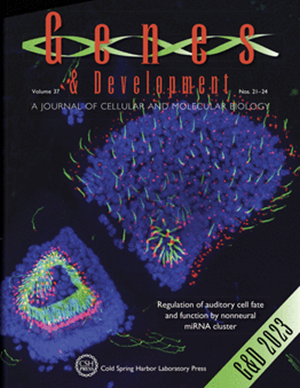体内CRISPR筛选揭示了肝胆可塑性的表观遗传调控因子
IF 7.7
1区 生物学
Q1 CELL BIOLOGY
引用次数: 0
摘要
长期肝损伤后,一小部分肝细胞经历重编程,成为胆管细胞或胆道上皮细胞(BECs)。这一生理过程涉及染色质和转录重塑,但表观遗传介质在很大程度上是未知的。在这里,我们利用肝损伤的谱系追踪模型来研究组蛋白翻译后修饰在胆道重编程中的作用。使用质谱法,我们定义了在重编程过程中全局数量改变的组蛋白标记库。接下来,应用体内CRISPR筛选方法,我们确定了七种改变肝胆重编程效率的组蛋白修饰酶。其中,组蛋白甲基转移酶和去甲基化酶Nsd1和Kdm2a被发现对H3K36甲基化具有相互作用,分别调节重编程的早期和晚期阶段。虽然Nsd1和Kdm2a的缺失会影响重编程效率,但细胞最终获得了相同的转录组状态。这些发现表明,多种染色质调节因子发挥动态和互补的活性来实现强大的细胞命运转换,作为在各种形式的生理性化生或重编程中发生的细胞身份变化的模型。本文章由计算机程序翻译,如有差异,请以英文原文为准。
In vivo CRISPR screening reveals epigenetic regulators of hepatobiliary plasticity
Following prolonged liver injury, a small fraction of hepatocytes undergoes reprogramming to become cholangiocytes or biliary epithelial cells (BECs). This physiological process involves chromatin and transcriptional remodeling, but the epigenetic mediators are largely unknown. Here, we exploited a lineage-traced model of liver injury to investigate the role of histone post-translational modification in biliary reprogramming. Using mass spectrometry, we defined the repertoire of histone marks that are globally altered in quantity during reprogramming. Next, applying an in vivo CRISPR screening approach, we identified seven histone-modifying enzymes that alter the efficiency of hepatobiliary reprogramming. Among these, the histone methyltransferase and demethylase Nsd1 and Kdm2a were found to have reciprocal effects on H3K36 methylation that regulated the early and late stages of reprogramming, respectively. Although loss of Nsd1 and Kdm2a affected reprogramming efficiency, cells ultimately acquired the same transcriptomic states. These findings reveal that multiple chromatin regulators exert dynamic and complementary activities to achieve robust cell fate switching, serving as a model for the cell identity changes that occur in various forms of physiological metaplasia or reprogramming.
求助全文
通过发布文献求助,成功后即可免费获取论文全文。
去求助
来源期刊

Genes & development
生物-发育生物学
CiteScore
17.50
自引率
1.90%
发文量
71
审稿时长
3-6 weeks
期刊介绍:
Genes & Development is a research journal published in association with The Genetics Society. It publishes high-quality research papers in the areas of molecular biology, molecular genetics, and related fields. The journal features various research formats including Research papers, short Research Communications, and Resource/Methodology papers.
Genes & Development has gained recognition and is considered as one of the Top Five Research Journals in the field of Molecular Biology and Genetics. It has an impressive Impact Factor of 12.89. The journal is ranked #2 among Developmental Biology research journals, #5 in Genetics and Heredity, and is among the Top 20 in Cell Biology (according to ISI Journal Citation Reports®, 2021).
 求助内容:
求助内容: 应助结果提醒方式:
应助结果提醒方式:


